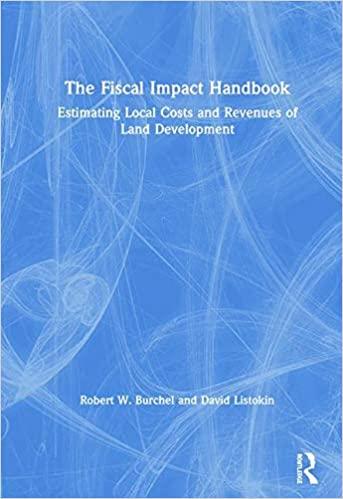Answered step by step
Verified Expert Solution
Question
1 Approved Answer
Using the same logic, compute the dividends, prices, and the present value of each of the dividends at the end of each period. The dividend
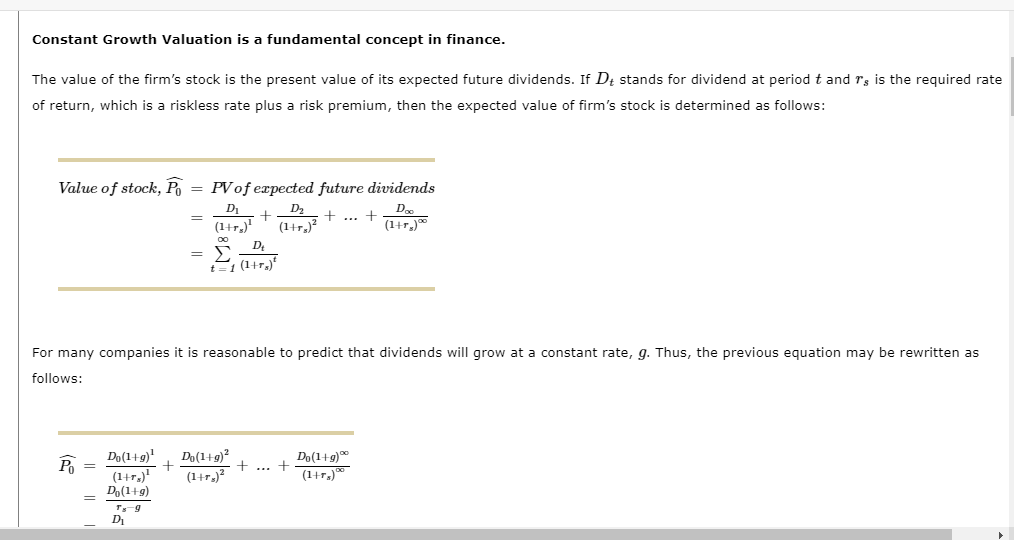
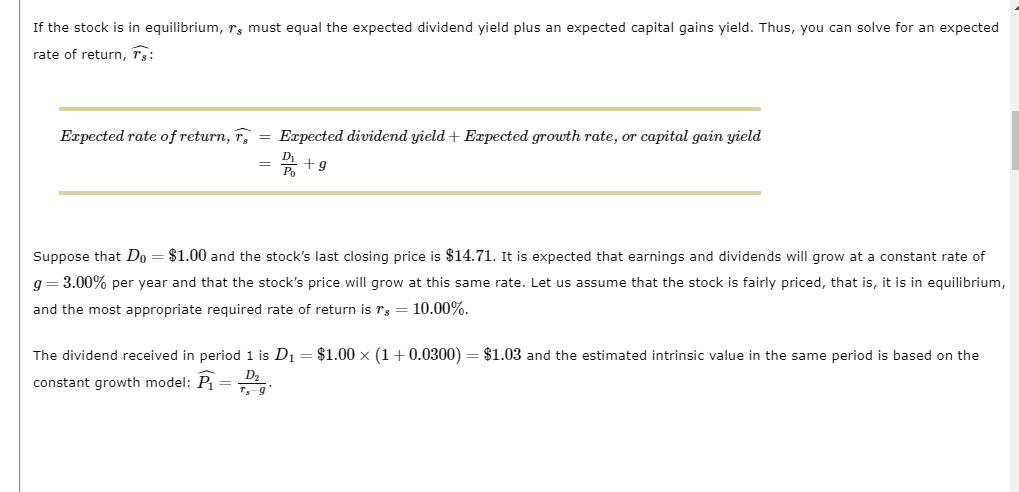

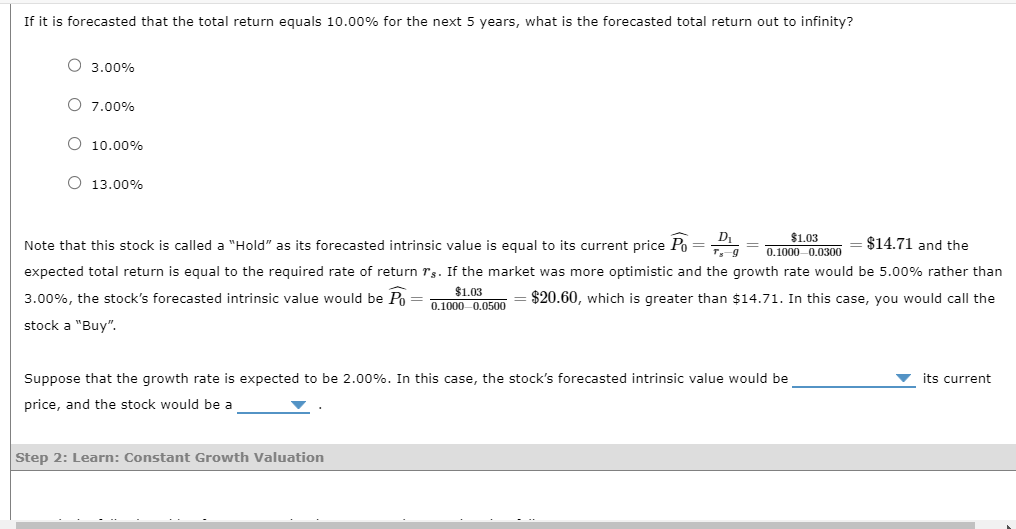
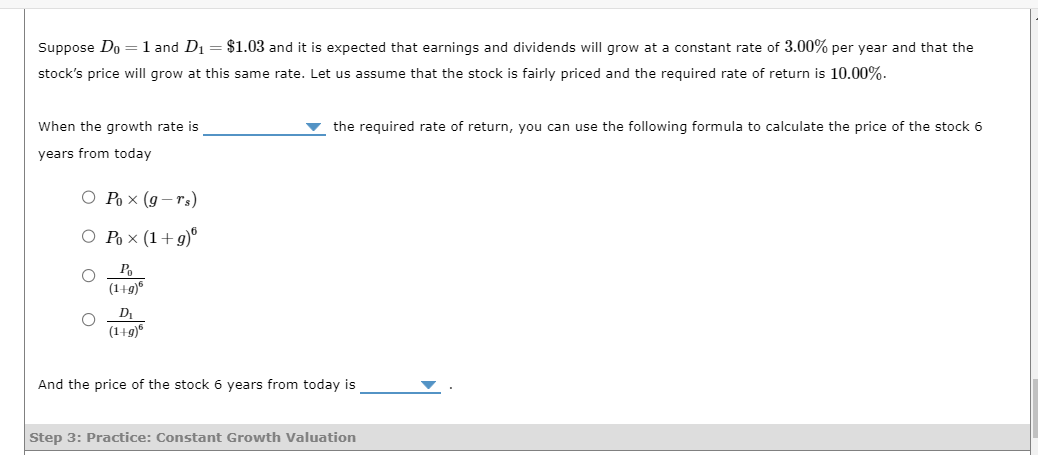
 Using the same logic, compute the dividends, prices, and the present value of each of the dividends at the end of each period. The dividend yield for period 1 is and it will each period. The capital gain yield expected during period 1 is and it will each period. Suppose D0=1 and D1=$1.03 and it is expected that earnings and dividends will grow at a constant rate of 3.00% per year and that the stock's price will grow at this same rate. Let us assume that the stock is fairly priced and the required rate of return is 10.00%. When the growth rate is years from today P0(grs)P0(1+g)6(1+g)6P0(1+g)6D1 the required rate of return, you can use the following formula to calculate the price of the stock 6 And the price of the stock 6 years from today is Step 3: Practice: Constant Growth Valuation Suppose that a stock is expected to pay a dividend of $4.85 at the end of this year and it is expected to grow at a constant rate of 3.00% a year. If it is required return is 10.00%. What is the stock's expected price 6 years from today? $17.56 $69.29 $82.74 $122.75 If the stock is in equilibrium, rs must equal the expected dividend yield plus an expected capital gains yield. Thus, you can solve for an expected rate of return, rs : Expected rate of return, rs= Expected dividend yield + Expected growth rate, or capital gain yield =P0D1+g Suppose that D0=$1.00 and the stock's last closing price is $14.71. It is expected that earnings and dividends will grow at a constant rate of g=3.00% per year and that the stock's price will grow at this same rate. Let us assume that the stock is fairly priced, that is, it is in equilibrium and the most appropriate required rate of return is rs=10.00%. The dividend received in period 1 is D1=$1.00(1+0.0300)=$1.03 and the estimated intrinsic value in the same period is based on the constant growth model: P1=rsgD2. If it is forecasted that the total return equals 10.00% for the next 5 years, what is the forecasted total return out to infinity? 3.00% 7.00% 10.00% 13.00% Note that this stock is called a "Hold" as its forecasted intrinsic value is equal to its current price P0=rsgD1=0.10000.0300$1.03=$14.71 and the expected total return is equal to the required rate of return rs. If the market was more optimistic and the growth rate would be 5.00% rather than 3.00%, the stock's forecasted intrinsic value would be P0=0.10000.0500$1.03=$20.60, which is greater than $14.71. In this case, you would call the stock a "Buy". Suppose that the growth rate is expected to be 2.00%. In this case, the stock's forecasted intrinsic value would be its current price, and the stock would be a Constant Growth Valuation is a fundamental concept in finance. The value of the firm's stock is the present value of its expected future dividends. If Dt stands for dividend at period t and rs is the required rate of return, which is a riskless rate plus a risk premium, then the expected value of firm's stock is determined as follows: Value of stock, P0= PVof expected future dividends =(1+rs)1D1+(1+rs)2D2++(1+rs)D=t=1(1+rs)tDt For many companies it is reasonable to predict that dividends will grow at a constant rate, g. Thus, the previous equation may be rewritten as follows: P0=(1+rs)1D0(1+g)1+(1+rs)2D0(1+g)2++(1+rs)D0(1+g)=rsgD0(1+g)D1
Using the same logic, compute the dividends, prices, and the present value of each of the dividends at the end of each period. The dividend yield for period 1 is and it will each period. The capital gain yield expected during period 1 is and it will each period. Suppose D0=1 and D1=$1.03 and it is expected that earnings and dividends will grow at a constant rate of 3.00% per year and that the stock's price will grow at this same rate. Let us assume that the stock is fairly priced and the required rate of return is 10.00%. When the growth rate is years from today P0(grs)P0(1+g)6(1+g)6P0(1+g)6D1 the required rate of return, you can use the following formula to calculate the price of the stock 6 And the price of the stock 6 years from today is Step 3: Practice: Constant Growth Valuation Suppose that a stock is expected to pay a dividend of $4.85 at the end of this year and it is expected to grow at a constant rate of 3.00% a year. If it is required return is 10.00%. What is the stock's expected price 6 years from today? $17.56 $69.29 $82.74 $122.75 If the stock is in equilibrium, rs must equal the expected dividend yield plus an expected capital gains yield. Thus, you can solve for an expected rate of return, rs : Expected rate of return, rs= Expected dividend yield + Expected growth rate, or capital gain yield =P0D1+g Suppose that D0=$1.00 and the stock's last closing price is $14.71. It is expected that earnings and dividends will grow at a constant rate of g=3.00% per year and that the stock's price will grow at this same rate. Let us assume that the stock is fairly priced, that is, it is in equilibrium and the most appropriate required rate of return is rs=10.00%. The dividend received in period 1 is D1=$1.00(1+0.0300)=$1.03 and the estimated intrinsic value in the same period is based on the constant growth model: P1=rsgD2. If it is forecasted that the total return equals 10.00% for the next 5 years, what is the forecasted total return out to infinity? 3.00% 7.00% 10.00% 13.00% Note that this stock is called a "Hold" as its forecasted intrinsic value is equal to its current price P0=rsgD1=0.10000.0300$1.03=$14.71 and the expected total return is equal to the required rate of return rs. If the market was more optimistic and the growth rate would be 5.00% rather than 3.00%, the stock's forecasted intrinsic value would be P0=0.10000.0500$1.03=$20.60, which is greater than $14.71. In this case, you would call the stock a "Buy". Suppose that the growth rate is expected to be 2.00%. In this case, the stock's forecasted intrinsic value would be its current price, and the stock would be a Constant Growth Valuation is a fundamental concept in finance. The value of the firm's stock is the present value of its expected future dividends. If Dt stands for dividend at period t and rs is the required rate of return, which is a riskless rate plus a risk premium, then the expected value of firm's stock is determined as follows: Value of stock, P0= PVof expected future dividends =(1+rs)1D1+(1+rs)2D2++(1+rs)D=t=1(1+rs)tDt For many companies it is reasonable to predict that dividends will grow at a constant rate, g. Thus, the previous equation may be rewritten as follows: P0=(1+rs)1D0(1+g)1+(1+rs)2D0(1+g)2++(1+rs)D0(1+g)=rsgD0(1+g)D1 Step by Step Solution
There are 3 Steps involved in it
Step: 1

Get Instant Access to Expert-Tailored Solutions
See step-by-step solutions with expert insights and AI powered tools for academic success
Step: 2

Step: 3

Ace Your Homework with AI
Get the answers you need in no time with our AI-driven, step-by-step assistance
Get Started


